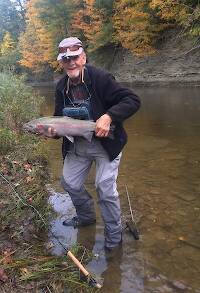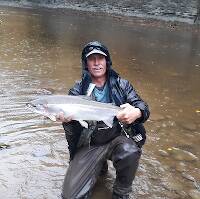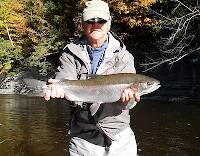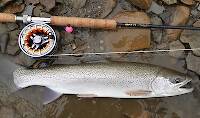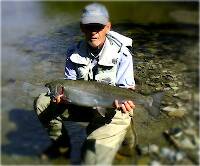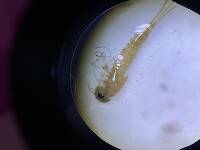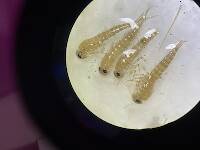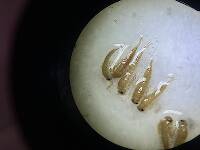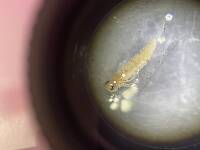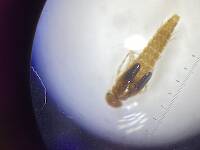
Hex Mayflies
Hexagenia limbata
The famous nocturnal Hex hatch of the Midwest (and a few other lucky locations) stirs to the surface mythically large brown trout that only touch streamers for the rest of the year.
Featured on the forum
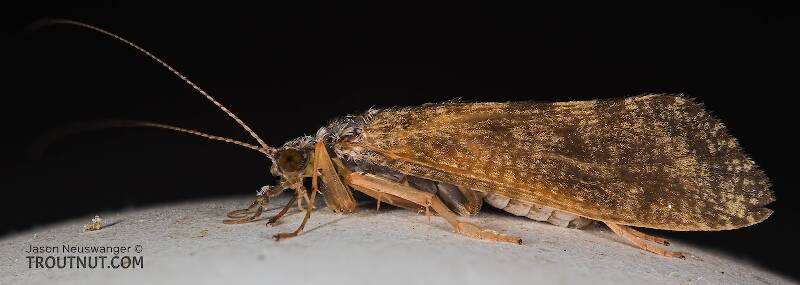

Troutnut is a project started in 2003 by salmonid ecologist Jason "Troutnut" Neuswanger to help anglers and
fly tyers unabashedly embrace the entomological side of the sport. Learn more about Troutnut or
support the project for an enhanced experience here.
Wbranch on Jul 24, 2007July 24th, 2007, 2:52 am EDT
On the WB but more often on the main stem of the Delaware I have seen sporadic emergences of a pretty large mayfly, maybe a #12, that has a deep yellow waxy colored wing and a tangerine colored body. I don't remember what color the legs or tails are so I can't offer more data for an identification but thought the size, wing and body color would be enough. They never seem to emerge in decent numbers and I can't ever remember seeing a trout eat one but I'm sure they must.
Catskill fly fisher for fifty-five years.
Taxon on Jul 24, 2007July 24th, 2007, 5:34 am EDT
Wbranch-
Sounds like Anthopotamus distinctus, previously classified as Potamanthus distinctus, and commonly called Golden Drake, Yellow Drake, etc.
Ames describes the female duns (on his local streams) as as being canary yellow except for the abdomen and fore legs, which are a salmony pink.
Sounds like Anthopotamus distinctus, previously classified as Potamanthus distinctus, and commonly called Golden Drake, Yellow Drake, etc.
Ames describes the female duns (on his local streams) as as being canary yellow except for the abdomen and fore legs, which are a salmony pink.
Wbranch on Jul 24, 2007July 24th, 2007, 7:54 am EDT
Hey Taxon,
Those colors are exactly like this dun! It is a very pretty fly and there are reasonable numbers on the Delaware system. Thanks.
Those colors are exactly like this dun! It is a very pretty fly and there are reasonable numbers on the Delaware system. Thanks.
Catskill fly fisher for fifty-five years.
GONZO on Jul 24, 2007July 24th, 2007, 11:54 am EDT
Matt,
I'd second Roger's ID as being most likely. They are one of the most beautiful mayflies. Though the golden drakes rarely hatch in great numbers, they can still be worth imitating. The rather unusual nymphs swim enticingly to emerge and can be worth imitating as well. I hesitate to mention it, but you can probably confirm the Anthopotamus ID by looking at the tails of the adults--the middle one is shorter than the outer two. Hey, as I've been known to say to my wife, what's wrong with looking at a little tail? ;)
I'd second Roger's ID as being most likely. They are one of the most beautiful mayflies. Though the golden drakes rarely hatch in great numbers, they can still be worth imitating. The rather unusual nymphs swim enticingly to emerge and can be worth imitating as well. I hesitate to mention it, but you can probably confirm the Anthopotamus ID by looking at the tails of the adults--the middle one is shorter than the outer two. Hey, as I've been known to say to my wife, what's wrong with looking at a little tail? ;)
Wbranch on Jul 24, 2007July 24th, 2007, 12:44 pm EDT
Gonzo,
The next time I see one that is within reach I'll try and catch it to examine the number of tails. Where do you than get the colors of the nymph? Maybe it is in Selective Trout by S&R.
I just re-read Roger's reply and I thought Potamanthus Distinctus had an all yellow body and wing; see color photo in Art Flick's
"Streamside Guide" on the color plate facing page 81. Do you think their could be so much difference in body color that the bug I see on the WB could have a tanferine/salmony pink abdomen?
The next time I see one that is within reach I'll try and catch it to examine the number of tails. Where do you than get the colors of the nymph? Maybe it is in Selective Trout by S&R.
I just re-read Roger's reply and I thought Potamanthus Distinctus had an all yellow body and wing; see color photo in Art Flick's
"Streamside Guide" on the color plate facing page 81. Do you think their could be so much difference in body color that the bug I see on the WB could have a tanferine/salmony pink abdomen?
Catskill fly fisher for fifty-five years.
GONZO on Jul 24, 2007July 24th, 2007, 12:57 pm EDT
Yes. Even within a species, color can be pretty variable. (Just ask Konchu.) The colors you describe are not unusual, however. Sometimes this is expressed as a deep orange stripe down either side of the abdomen (and some members of Anthopotamus/Potamanthus are whitish). The nymphs are often a heavily mottled/barred tan and brown, and they have very prominent feathery lateral gills. (These gills would be worth imitating for movement alone, to pick up on your post about "Gills.") Hatches and Ames' Hatch Guide for New England Streams both have good pictures of the nymphs, as do several other more recent books. (Although, if you ask, Roger can probably post a picture for you.)
Wbranch on Jul 24, 2007July 24th, 2007, 1:22 pm EDT
Thanks for your adroit information. It appears that there are many bug men here with advanced insect knowledge. I've seen some humongous mayflies on the Susquehanna and always wondered what they were. From now on if I see any I'll try and catch one and photograph it to see if you fellows can identify it for me.
Catskill fly fisher for fifty-five years.
GONZO on Jul 24, 2007July 24th, 2007, 1:50 pm EDT
The humongous ones are probably Hex (Hexagenia) of at least two species--the Breeches has them, too.
Konchu on Jul 24, 2007July 24th, 2007, 2:00 pm EDT
I think Heptagenia culacantha is found on the Susquehanna River, too.
GONZO on Jul 24, 2007July 24th, 2007, 2:09 pm EDT
Really?!! Now that's one to watch for! I knew the Delaware had them, but I didn't know they could be found so close to home. Thanks, Konchu.
Quick Reply
Related Discussions
Topic
Replies
Last Reply
2
Jul 2, 2009
by DayTripper
by DayTripper
7
Jan 22, 2010
by Taxon
by Taxon
1
Jun 12, 2007
by Troutnut
by Troutnut





